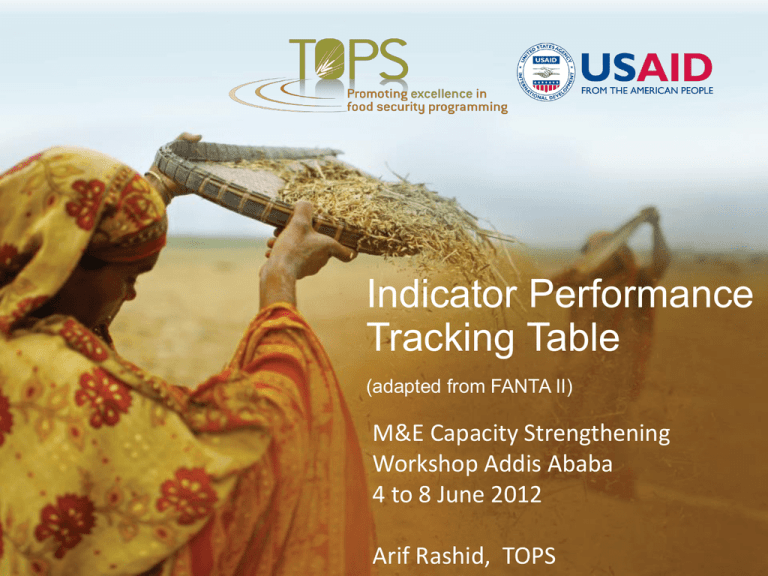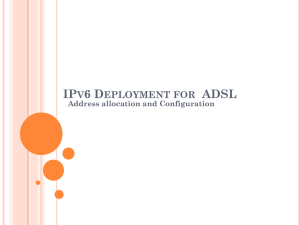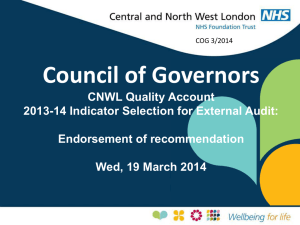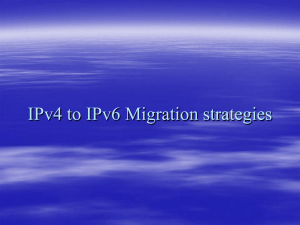
Indicator Performance
Tracking Table
(adapted from FANTA II)
M&E Capacity Strengthening
Workshop Addis Ababa
4 to 8 June 2012
Arif Rashid, TOPS
What is IPTT?
“The indicator performance tracking table
(IPTT) …includes performance indicators (at the
impact, outcome and output levels) linked to
the food aid program proposal’s objectives, and
baseline and target values for each indicator
(estimated)”
Source: http://www.usaid.gov/our_work/humanitarian_assistance/ffp/ffpib_09.06.pdf
Slide # 1
Purpose of IPTT
Criteria for reviewing an IPTT to help ensure
that it
• helps you to improve your program
• helps you to meet your reporting
requirements and
• helps you conduct M&E in ways that are
not too costly or burdensome.
Slide # 2
How will you use your IPTT?
Slide # 3
How will you use IPTT? – 15 minutes
• Identify two volunteers in your group.
• The first volunteer: take a copy of your IPTT and do the
following:
• Choose one indicator and explain to your group how you will
use it to report to Food for Peace.
• Choose a different indicator and explain how you will use it to
improve your program.
• Choose a different indicator and explain how you will use it to
“tell your story” (to tell other organizations, other funders,
communities or beneficiaries about your project).
• The second volunteer should repeat the same.
Slide # 4
How will you use IPTT? – 15 minutes
As a group, please select one section of your IPTT.
Then look over each indicator in that section and LABEL
each indicator as helping you to:
• Fulfill reporting requirements
• Improve your program
• Tell your story.
• NONE OF THE ABOVE.
JUST LABEL, DON’T MAKE REVISIONS YET
Please take 15 minutes for this exercise.
Slide # 5
How will you use IPTT? – 15 minutes
Tell your group members:
• One thing that you found out about indicators
or your IPTT that you didn’t know before.
• One thing you plan to do differently as a result
of what you’ve learned.
Slide # 6
How are RF and Indicator levels related?
Overarching
Goal
Impact Indicators/
Higher Outcome Indicators
Medium/ Immediate
Outcome Indicators
Strategic
Objective 1
Intermediate
Result 1.1
Intermediate
Result 1.2
Strategic
Objective 2
Intermediate
Result 2.1
Outputs
Processes
Inputs
Activities:
a)
b)
c)
Activities:
a)
b)
c)
Activities:
a)
b)
c)
Slide # 7
Need indicator at every level
Goal
SO
IR
Activities
Farm incomes
increased
Production of non-traditional crops
increased
20 Farmers planted the new crop and followed the
intercultural practices learned from the project
Project trained 50 farmers on non
traditional crops, and distributed seeds
and fertilizer
Slide # 8
Linking Indicators to RF
• In small groups take the activity assigned to you and
create 3 indicators to measure the causal chain the
activity is part of, one at each level, output, outcome,
impact:
– Activity 1: Training on proper hand washing techniques
– Activity 2: Training farmers on improved crop
management techniques
– Activity 3: Training on crop storage systems
• You have 15 minutes- 5 minutes per indicator! Use the
worksheet in the binder
• Be prepared to share your indicators with the rest of the
participants
Slide # 9
Develop Indicators at Each Level
Activity assigned to your working group:
Level of the
Indicator (result)
General Guideline
Impact (SO level)
The change in the condition or situation of the
population
Measures the highest level of change your project
is responsible for bringing about
Outcome (IR level)
Very often this is a behavior (acting,
practicing) or knowledge change, but not
always. There are higher and lower level
outcomes, i.e. the higher level outcome
could be increases in production while a
lower level outcome would be the practices
that a beneficiary uses.
Output (activity
level)
Direct product of the implementer’s activities
Your Proposed
Indicator
Slide # 10
IPTT Checklist Criteria
What to ask yourself when
developing or assessing your IPTT
Slide # 11
What jobs can your indicator do?
Does each indicator serve at least one of the following purposes:
• reporting,
• telling your story or
• improving your program?
• For example: does it provide other interesting
information– i.e. information that indicates whether the
food security situation is improving? whether communities
and beneficiaries are making progress? how well we are
doing in implementing?
Slide # 12
Does each indicator measure a specific
result?
Overarching
Goal
Impact Indicators/
Higher Outcome Indicators
Medium/ Immediate
Outcome Indicators
Strategic
Objective 1
Intermediate
Result 1.1
Intermediate
Result 1.2
Strategic
Objective 2
Intermediate
Result 2.1
Outputs
Processes
Inputs
Activities:
a)
b)
c)
Activities:
a)
b)
c)
Activities:
a)
b)
c)
Slide # 13
IPTT Checklist Criteria
Is each indicator precise and well
defined enough to give the reader
a clear idea of what is being
measured?
Which is more precise?
1. “% of children malnourished”
OR
2. “% of children 6-59 months in the target
population who are underweight (weightfor-age Z score < -2)”
Slide # 14
IPTT Checklist Criteria
Is it FEASIBLE to collect and analyze the
data for each indicator?
Slide # 15
IPTT Checklist Criteria
Is it FEASIBLE to collect and analyze the
data for each indicator?
Some suggested questions to ask about each
indicator:
• Can you collect its data through either a populationbased household survey, annual survey of
beneficiaries or from program records?
• Does your program have the expertise, resources and
the staff needed to measure this indicator?
• Does it make sense to collect data for this indicator at
the time of year you plan to do so (e.g. baseline,
annual and final surveys)?
• Can you get a big enough sample size to produce
reliable data?
Slide # 16
IPTT Checklist Criteria
Is it FEASIBLE to collect and analyze the
data for each indicator?
• An IPTT should not have too MANY or too FEW
indicators. A BALANCED set of indicators that
captures all three aspects – reporting, telling your
story and improving program management is
expected.
Slide # 17
IPTT Checklist Criteria
Does the IPTT include gendersensitive indicators appropriate to
your RF?
•
Your IPTT should include gender sensitive indicators that:
– Go beyond disaggregation by sex and are not just about women
– Are based on the social context and gender relations (i.e. What
role does gender play in the results the MYAP wants to achieve;
Do mean and women get equal benefits from the project
activities; Who put more labor to carryout activities promoted by
the project?
•
Examples:
– Men’s knowledge about exclusive breastfeeding
– Men’s participation in helping woman get to pre-natal visits
– Ratio of women’s to men’s use of inputs OR increased yields
Slide # 18
IPTT Checklist
Are indicators numbered clearly? Each indicator should have a unique
identifying number so they are easy to refer to
Is each required indicator labeled as such? Required indicators must be
included in the IPTT and it’s helpful if the group requiring the indicator is
mentioned, i.e. (Mission), (FFP), (Government)
Is the wording for each indicator neutral? (E.g. “% of children
exclusively breastfed until 6 months” NOT “increase in the “% of children
exclusively breastfed until 6 months)
PROGRAM GOAL: Reduce Food Insecurity of Vulnerable Populations in
Western Province
SO 1: Improved livelihood capacities of vulnerable households
Impact
1.1 Average Household Dietary
Diversity Score (FFP)
(+)
Outcome
1.2 Percent of trained beneficiaries
(+)
scoring 70% or above on post-test
scores
Slide # 19
IPTT Checklist
•
Are all the targets in the right place (“Annual” vs. “Baseline,
Mid-term Evaluation and Final Evaluation”)
PROGRAM GOAL: Reduce Food Insecurity of Vulnerable Populations in Western
Province
SO 1: Improved livelihood capacities of vulnerable households
Impact
1.1 Average Household Dietary Diversity
Score (FFP)
Outcome 1.2 Percentage of households with
access to an improved sanitation
facility
(+)
(+)
Slide # 20
IPTT Checklist Criteria
Is each target
reasonable?
• Can you reasonably expect to reach the target? Is it
ambitious enough to make a difference to your
beneficiaries?
• Can you justify your targets? For example is the
target based on your organization’s past experience
with a Title II program or another similar program?
Slide # 21
IPTT Checklist
• Are targets clearly defined as
cumulative or not?
• Do all targets match their indicator in
units? Targets are in same format as the indicator (i.e. indicator says
“Number of …” but target says “50%”)
Slide # 22
This presentation was made
possible by the generous
support of the American people
through the United States
Agency for International
Development (USAID). The
contents are the responsibility
of Save the Children and do not
necessarily reflect the views of
USAID or the United States
Government.








